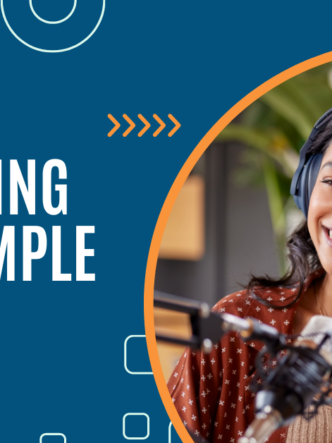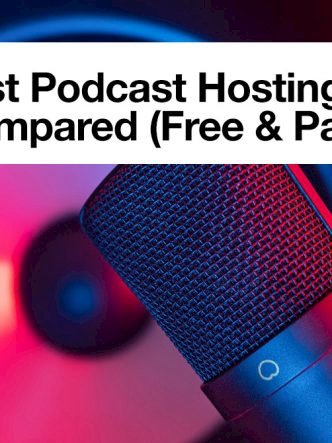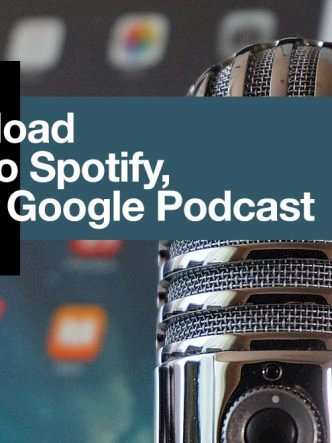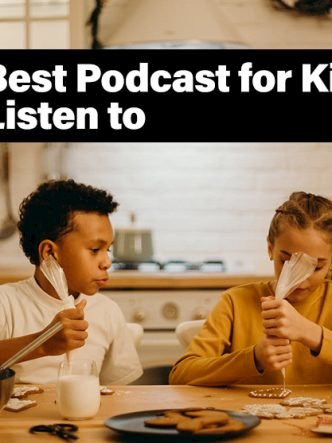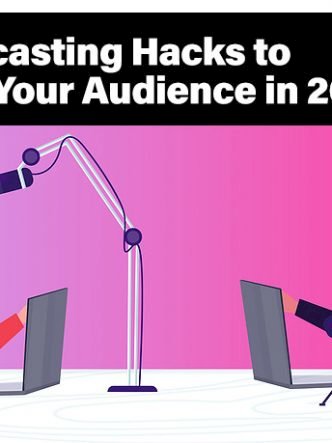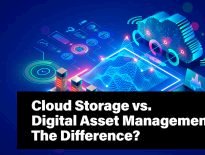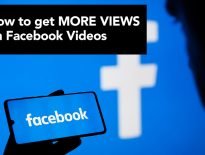
Google trends show that podcasting began to gain popularity in about 2004 when more and more people began to enter the industry. Smartphones and the ability to tune in through various listening platforms have increased the popularity of podcasts. By creating podcasts, brands can connect with a potentially untapped customer base in an authentic way. If you want to know how to start a podcast, here is an easy guide to follow.
01. What is a Podcast?
The term podcasting has been derived from the words “iPod” and “broadcast.” A podcast is a spoken word, digital, audio file a user can download to a personal device, such as a computer or mobile device. They can then listen to them whenever and wherever they wish. Anyone with an internet connection and a pair of headphones can listen to them.
Podcasts cover thousands of different topics and individuals can access them for free across a variety of platforms. They are typically available as a series and subscribers can receive new installments automatically. With the amount of content, podcasting provides regular radio stations simply can’t compete.
02. Kinds of podcasts
With all the different kinds of podcasts, it is important to analyze the competitive landscape and see how podcasts with similar topics to ones you want to make format their shows. The structure should also align with your audience and complement the topic you choose. Following a consistent style means an audience knows what to expect when it tunes in.

Interview format: An interview-style format is when a podcast host interviews a new guest in each episode. The host asks questions and guides the conversation about the topic to bring out the expertise and experience of the guest.
The advantages of this format are that the guests do most of the talking and they will promote their appearance on your podcast, bringing you new listeners. The disadvantages are that this is an extremely popular format and you will need to stand out to draw attention. Interviewing is a skill that takes practice and finding new guests, doing research about them, and relying on their ability to entertain can be difficult.
The solo/monologue format: Many people start with this format because they just talk into a microphone and all they need is the microphone and some editing software. You may want to use this format if you have specific expertise to share. It will help to write a detailed script instead of trying to ad-lib.
The advantages are that you don’t have to rely on anyone else. You can go at your own pace and editing one voice is much easier than editing multiple tracks. Some cons of this approach are that it can be tiring to talk for so long and you don’t have anyone to bounce ideas off.
Conversational podcast format: This type of podcast involves two people having a conversation with both acting as hosts and playing a specific role. For example, one may give a news snippet and the other may provide commentary on it.
One of the advantages is that the audience may find it easier to listen to an organic conversation than a script. You are only responsible for half of the conversation and you can split the other tasks too. Both parties do need to stay on the same page and it is more difficult to edit and find topics you are both confident to discuss.
It is important that a podcast should fulfill your audience’s needs – either by solving a problem, educating, or entertaining listeners. As more listeners connect with a podcast, there are more opportunities to turn them into customers.
03. What podcasting equipment do you need?
Professional podcasts may use a variety of equipment to record their podcasts, including microphones, mixers, audio interfaces, etc. However, all this equipment can be expensive. All you really need in terms of podcast equipment is the right microphone, headphones, and recording and editing software.

Microphone: When choosing a microphone, you will need to consider how you’ll connect it. There is a good chance that what you are using to record your podcast has a USB port built-in. This makes a USB microphone easy to connect. To get it running, just make sure you select the right microphone in the “input” panel of your podcasting software.
You will also need to consider the difference in sensitivity between different types of microphones. Dynamic microphones, for instance, are less sensitive to sound than condenser microphones which make the sound more nuanced and natural. However, capturing background noise is less risky than when using a condenser microphone.
The space you will record in and the number of people you will usually be recording will also affect your microphone choice. It’s important to record in a space where there is a soft material to soak up the sound. If you regularly record with additional speakers, you will need to look into an audio interface.
A pop filter: This can help to reduce the harshness of words and explosive sounds. For example, words like ‘please’ or ‘powerful’ can create wind noise.
Over-the-ear headphones: These are better than earbuds with the recorder picking up a voice more clearly.
Audio recording and editing software: Local or remote recording requires different software. For local recordings where everyone is in the same room, Audacity is widely used because it’s easy to use and free. Remote recordings where people being recorded are in different locations will require a different type of software. Zencastr has a free plan that lets you record up to eight hours per month for up to two guests in MP3 format. Audacity has a low learning curve when it comes to editing. Adobe Audition offers more bells and whistles for editing but you need a paid subscription.
Once your podcast grows and you begin making some money from it, you can invest in improving your equipment.
04. Hosting a podcast

In order to create an RSS feed for a podcast, you need to upload the audio file to a podcast hosting provider. Each time you upload new content, the hosting provider automatically updates the RSS feed. Choosing a reliable hosting platform is crucial because it helps you grow your audience faster and makes it easier to manage your podcast files.
Podcast hosting providers can store and deliver large media files. Many companies offer podcast hosting services and it is best to go for ones that are user-friendly and offer great tools and support.
Cincopa is one platform that will take care of hosting your podcasts and deliver and perform all updates automatically. All you need to do is upload your new media files and subscribers and visitors can enjoy them instantly.
Regardless of which podcast hosting service you choose, you will need a media player to embed and display podcasts on your website.
Cincopa has over 25 podcast player templates where you can add menus, images, and cover art. Cover art is what people will see first and if you are not able to create your own cover art, it is easy to find freelance designers to create some designs for you to choose from. You can set the size of the template and customize the background, icons, text, and slider colors.
All you need to do is upload the media files you want to broadcast into Cincopa’s cloud-drive with drag-and-drop, and then organize them in folders. Cincopa has a simple wizard that automatically manages any conversions and transcoding needed. You mark whether you’re using Joomla, WordPress, etc. on your site and make sure you’ve downloaded a suitable add-on. Cincopa generates a line of code that you can copy and paste to wherever you want to display your podcast player.
When you add a specific section to your site that houses podcast episodes, each one creates additional SEO opportunities to enhance organic traffic and helps to boost SEO ranking.
Your podcasts should include a CTA (call-to-action) to encourage your listeners to take further action, such as subscribing or signing up for a newsletter.
05. Podcast on iTunes and Spotify
Enticing podcasts will benefit your business over the long term when episodes are always available on-demand on iTunes, Spotify, or Apple Podcasts. Many target audiences are searching for podcasts and you can cover niche topics to reach smaller but more engaged listeners.
Searching by topic is the way most people go about finding a podcast when using a listening app. Apple Podcasts, for instance, has more than 65 primary categories and subcategories for listeners to search and choose from.
Google Podcasts is Google’s stand-alone app for podcasts. The free app for iOS and Android is integrated with Google Assistant and Google Home. It is fairly minimalistic with a simple interface and few features.
Listeners can get notified via their favorite podcast app when new episodes come out.
06. Some of the best podcasts?
The best podcasts can be highly engaging and offer more intimate content than written content.
Serial
is probably one of the most famous podcasts and it drew thousands of listeners when it came out in 2014. They tuned in to listen to the 12-part podcast developed by This American Life. It told the true story of Adnan Syed, the former boyfriend of Hae Min Lee, an 18-year old high school student, and his conviction for killing her.
The Laptop Lifestyle
is an interview-style podcast for millennials and virtual entrepreneurs. Its intention is to educate, challenge, and inspire people to live the life they have always wanted, where they earn a living online and set their own schedules.
Flash Forward
is a podcast about future scenarios. Each episode goes deep into possible future tomorrows and what they could really be like. It combines technology, philosophy, ethics, and science. Journalist Rose Eveleth interviews experts to unearth all kinds of questions about the future you’ve never asked before.
Hardcore History
blends excellent narration, high drama, and twists. Dan Carlin applies his unorthodox thought process to the past and entertains millions of listeners.
Stuff You Should Know
features Chuck Bryant and Josh Clark discussing a broad range of topics such as narcolepsy, heroin, stuttering, and Satanism. This is a great podcast to listen to for interesting conversation starters.
The Daily
is a podcast by the New York Times that discusses daily news. It is hosted by political journalist Michael Barbaro. The episodes feature interviews with journalists.
A final word
Podcasts have brought new life to old audio formats with creative ways to tell stories, educate listeners and share personal insights. They are quick and easy to download and stream, making them the perfect way for individuals to listen to them while doing tasks, exercising, or traveling to work. Making a podcast is not that difficult, especially when using the above information as a guide. Podcasts are an effective way for businesses to connect with consumers today in a way that they enjoy.


